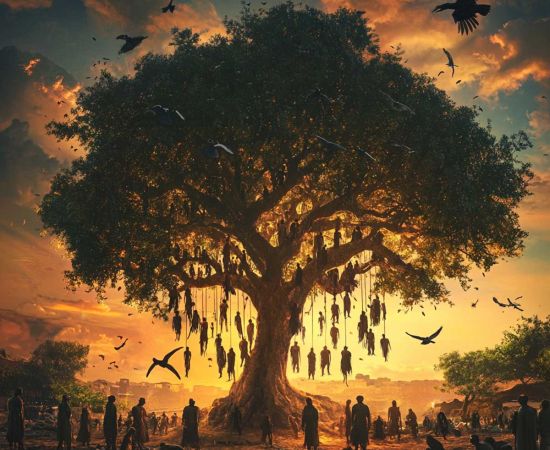MORE COVERAGE
Twitter Coverage
Satyaagrah
Written on
Satyaagrah
Written on
Satyaagrah
Written on
Satyaagrah
Written on
Satyaagrah
Written on
JOIN SATYAAGRAH SOCIAL MEDIA
"छलावा": Evangelists like CBN India in Bharat are leveraging the soft power of local culture, from Bhangra Christmas carols to Garhwali hymns, subtly repurposing Bharatiya traditions for large-scale Christian conversions, & reshaping religious identities

In a recent publication by the widely read English daily, The Times of India, an article on Christmas portrayed an image of vibrant multiculturalism in Bharat, focusing on how the festival of Christmas has seemingly blended with the local cultures and flavors of the nation. At first glance, this piece appears to celebrate the diversity and adaptability of cultures as it describes the trend of Christmas carols and hymns being adapted to the style of tappe-boliyan and bhangra beats, a fusion indicative of Christianity's assimilation into Bharatiya traditions.
However, this seemingly benign portrayal of cultural integration raises critical questions about the underlying motives and consequences, particularly in the context of Christian conversions in Bharat. The article, tailored for an English-educated, liberal-minded Bharatiya audience – the core readership of The Times of India – might come across as a fascinating insight into the blending of Bharatiya culture with Christian traditions. Yet, what it glosses over, and what remains unseen by many, is the stark reality of Christian evangelism in the country.
The integration of Christian elements into local traditions, as described, is not merely a benign cultural exchange. It can be seen as a strategic move by evangelists to make Christianity more appealing and relatable to the local population. By wrapping Christian beliefs in the familiar garb of Bharatiya traditions and music, the process of conversion is potentially made smoother and less confrontational. This approach, while celebrated by some as a form of cultural harmony, could also be interpreted as a subtle yet powerful tool for religious conversion.
The article in The Times of India, while highlighting the assimilation of Christianity into local culture, fails to address the deeper and more contentious issue of religious conversion. It overlooks the complexities and often the contentious nature of such conversions in Bharat, where religion is deeply intertwined with identity and heritage. The celebration of this 'cultural confluence' tends to mask the aggressive conversion tactics employed by some evangelists, who may use local cultural elements as a veneer to further their religious agenda.
This narrative of cultural blending, thus, becomes a double-edged sword. While it showcases the ability of different cultures to influence each other, it also raises the specter of cultural appropriation for the purpose of religious expansion. The so-called glorious example of Christianity assimilating local traditions, as argued in the article, becomes a subject of scrutiny and criticism when viewed through the lens of ongoing efforts at religious conversion.
The strategy of Christian conversions in Bharat has long involved the appropriation of local folk culture and traditions. This approach includes the superimposition of traits and characteristics of Hindu Gods and Goddesses onto Christian figures, a tactic deeply embedded in the conversion industry. This method suggests a calculated shift in strategy: when traditional Western methods and English hymns fail to attract followers to the Abrahamic faith, the missionaries turn to using elements of the local culture to draw people into Christianity. This appears to be a primary modus operandi in the northern regions of Bharat, where states like Punjab have already seen significant evangelization, and now the focus is shifting to states like Himachal Pradesh and Uttarakhand.
This tactic of using regional languages, folk cultures, and traditions that are intrinsically linked to Hindu Dharma is increasingly being weaponized by evangelists to expedite conversions. Such actions not only demonstrate a strategic adaptation of missionary activities but also raise concerns about the erosion of native cultural and religious identities.
Furthermore, the systematic anti-Hindu propaganda of Christian missionaries in southern Bharat has been well-documented, especially since colonial times. The Sangam literature and the rich culture and tradition of Tamil Nadu, for example, have been deliberately dissociated from Hindu Dharma. One of the most significant strategies in this context has been the promotion of the pseudo-Aryan-Dravidian divide. This divide, based on the now-discredited Aryan Migration Theory, was largely a ploy by Christian missionaries to create a rift between the north and south of Bharat, aiding in large-scale Christian conversions in the southern regions.
 |
| https://timesofindia.indiatimes.com/ |
Renowned scholar and writer Rajiv Malhotra has discussed this issue in depth in his book “Breaking India: Western Interventions in Dravidian and Dalit Faultlines.” Malhotra explains how the Dravidian identity was deliberately manufactured to propagate an anti-Bharat and anti-Hindu narrative in the south. This narrative was instrumental in bolstering the conversion of Hindus to Christianity, as it aimed to detach them from their roots and present Christianity as a more appealing alternative.
Unfortunately, the tactic of cultural appropriation, a critical element in the strategy for Christian conversions in Bharat, is now being increasingly adopted in the northern regions, particularly in states like Punjab. This method involves integrating elements of local culture into Christian practices, creating a facade of cultural harmony while subtly promoting conversion. Such tactics, while seemingly benign, carry the potential to significantly alter the historical and cultural landscape of these regions.
Taking Punjab as an example, there's a concerning possibility that, after extensive evangelization, the rich Hindu and Sikh history of the region might be overshadowed by an alternative Christian narrative. This could lead to claims that the original religious history of Punjab is fabricated, replaced by a version more favorable to Christian evangelists. While this scenario might seem dystopian, it's a potential future that needs to be acknowledged and guarded against. The danger lies in the gradual erasure of local cultures and traditions under the guise of religious conversion, which can distort and eventually replace the indigenous historical narrative.
The article in The Times of India, titled “Jingle bells with ghungroos and Bhangra: Christmas gets a twist and desi soundtrack”, exemplifies this approach. It describes how Christmas celebrations are being adapted to include local cultural elements, such as adding bhangra beats to carols or transforming old Tamil hymns with country music styles. This sort of fusion in the conceptualization and production of Christmas carols is portrayed as a celebration of Christ's birth in ways that are more relatable and locally specific.
However, the underlying motive behind such adaptations can be seen as more insidious than celebratory. While the article glorifies this amalgamation, presenting it as a harmonious blend of local culture with Christian practices, it overlooks the strategic intent behind these adaptations – to make Christianity more appealing and accessible to the local population. This is not merely a case of cultural exchange but a calculated effort to reframe Christian beliefs within the familiar context of local traditions, thereby easing the process of conversion.
The ramifications of such tactics are profound. By co-opting local cultural elements, evangelists not only make inroads into new communities but also risk diluting and eventually supplanting the indigenous cultural and religious identities. The appropriation of cultural practices and traditions, under the pretext of religious celebration, becomes a tool for expanding religious influence and altering the cultural fabric of the region.
Recent media articles, including those in major English dailies in Bharat, have brought to light a disturbing trend: the normalization and even outright glorification of the Christian conversion industry. These articles often rapturously describe the cultural amalgamation of Christian and Bharatiya traditions as a positive phenomenon. However, a deeper examination reveals a more concerning reality. The adaptation of Christmas carols and hymns into Bharatiya languages and styles is not a genuine appreciation of Bharatiya culture. Instead, it serves as a tool for soft propaganda, aimed at subtly influencing Hindus.
The massive popular culture industry that has emerged around producing Christmas carols in Bharatiya languages is a clear manifestation of this strategy. Far from being an innocent cultural exchange, it represents a calculated effort to make Christian beliefs more palatable and attractive to the Hindu population. The Bharatiya English media, often filled with articles that uncritically glorify such cultural appropriation, either seems unaware of the true nature of these conversions or is possibly complicit in masking their real intent.
A simple YouTube search using terms like “Christmas Bhangra” can be eye-opening. It yields thousands of professional videos that deliver the “messages of Jesus Christ” in local Bharatiya languages, employing popular regional music and dance styles like Bhangra, Dandiya, and even Garhwali. The sheer number of these videos, and the sophistication of their production, indicates a well-organized effort to target Bharatiya audiences. Moreover, the existence of hundreds, perhaps even more, YouTube channels with substantial subscriber bases dedicated solely to content for Bharatiya Christians further underscores this point. A cursory review of these channels reveals their potential role in evangelization, as they deliberately reach out to Bharatiya users from different states using local folk music and dance traditions.
These channels are more than just platforms for religious content; they are strategic tools designed to appeal to the cultural sensibilities of different Bharatiya communities. By leveraging familiar and beloved aspects of local culture, these evangelization efforts are subtly woven into the fabric of everyday life, making them more effective and less conspicuous.
Critical Analysis of CBN India's Role in Christian Conversions in Bharat
One particular YouTube channel, CBN India, exemplifies the sophisticated and widespread nature of Christian evangelization efforts in Bharat. With over 87,000 subscribers, the channel is a repository of Christian propaganda videos aimed at evangelizing Bharatiyas. The content on this channel includes a diverse range of culturally adapted Christmas videos, such as Garhwali, Malayalam, Gujarati, Chhattisgarhi, and Nepali Christmas specials. These videos are professionally produced, featuring local artists from various states of Bharat who, whether knowingly or unknowingly, are becoming instrumental in facilitating Christian conversions. The prevalence and professionalism of these videos highlight a deeply alarming situation, where cultural appropriation is being used strategically to further religious conversion goals.
CBN India also operates a website, which provides further insight into their activities and objectives. Interestingly, their self-description is not overtly religious. The “About us” section of the website states, “CBN India is an organization that builds communities of hope mainly through media by documenting real life stories and messages of hope in the face of adversity. CBN India media content provides a moral compass for those lost in the darkness of despair.” This description, while seemingly benign, masks the true nature of their operations. Located in Gurugram, the organization, upon closer examination, reveals itself to be a Christian evangelist entity with a clear agenda of furthering Christian conversions in Bharat.
The “Connect with us” section of CBN India's website includes a link for Church Choir Registration, indicating their religious affiliations. Moreover, the website features testimonies from Bharatiya Christians who narrate how adopting Christianity has positively transformed their lives. These stories are not just personal accounts but serve as tools for evangelization, portraying Christianity as a solution to various life challenges and a path to personal improvement.
The “Resource Center” section of the website further confirms the channel's evangelistic nature. It houses a collection of podcasts based on verses from the Bible, providing a direct link to Christian teachings. This assortment of religious content, masked under the guise of hope and moral guidance, is a strategic approach to appeal to a diverse and wide audience in Bharat.
The Covert Tactics of Christian Conversion Organizations in Bharat
The mission statement of CBN India, which reads “We transform communities through stories of hope”, is a strategic representation that serves a dual purpose. On the surface, this statement positions the organization as a source of motivational and inspirational media stories. However, a closer examination suggests that this façade is a clever tactic to evade government scrutiny, as their primary aim appears to be the dissemination of Christian propaganda to boost conversions in Bharat. Their YouTube channel is more overt in showcasing their evangelical roots, indicating a more direct approach in their online presence.
This situation is not unique to CBN India. There are likely hundreds of similar organizations operating in Bharat with the sole objective of evangelizing Hindus. The absence of a central anti-conversion law leaves a legal vacuum, making it challenging to contest the activities of these organizations. Many of them skillfully disguise themselves as charities or organizations promoting inspiration and motivation, making it difficult to confront them directly for their evangelistic activities.
The tactics employed by these evangelist organizations are not only covert but are also evolving rapidly, becoming increasingly sophisticated. This evolution calls for a nuanced approach to understanding and addressing the issue. As noted by politico-religious observer and anti-conversion campaigner Jerome Anto in a recent interview with Hindupost, the state needs to engage with experts in the field to gain an insider's perspective on the functioning of the Christian conversion industry in Bharat. This collaboration is essential to develop effective strategies to counter the subtle and often insidious methods of conversion being employed.
Anto's insights highlight the need for a more informed and strategic approach to tackle the issue of religious conversion in Bharat. The complexity of these conversion tactics, which often involve the appropriation of local cultures and the masking of evangelical intentions under the guise of charitable or motivational work, requires a multi-faceted response. This response should not only involve legal and policy measures but also a deeper understanding of the cultural and social dynamics at play.
The challenge lies in identifying and addressing these covert operations without infringing on genuine charitable or inspirational initiatives. It is crucial for the government and civil society to distinguish between genuine social work and covert evangelistic activities, ensuring that the rich cultural and religious diversity of Bharat is preserved while respecting the right to religious freedom. This delicate balance is key to maintaining the social fabric of Bharat and protecting its citizens from manipulative conversion tactics.
In the intricate landscape of religious conversions in Bharat, one of the most potent tools employed by Christian evangelists is the soft power of Bharatiya culture itself. It is an ironic and concerning phenomenon where the very essence of local Bharatiya customs and traditions, which are deeply rooted in the country's history and collective consciousness, are being repurposed to facilitate large-scale conversion of Hindus to Christianity.
This approach is concerning because it has the potential to gradually erode the religious and cultural identities of Hindus. As these converted practices become more commonplace, they risk distorting the understanding and perception of traditional Hindu customs. Over time, this could lead to a cultural and religious shift where the original meanings and significance of these practices are overshadowed or replaced by their Christianized versions.
The use of Bharatiya culture as a tool for conversion also raises ethical questions about the authenticity and respect for the cultural traditions being appropriated. It points to a larger strategy of cultural infiltration and adaptation employed by Christian missionaries, which goes beyond straightforward religious preaching. Instead, it involves a deeper level of cultural engagement, aimed at transforming the religious landscape of Bharat from within.
This situation calls for a heightened awareness and understanding of these tactics among Hindus and the broader Bharatiya society. Recognizing and critically evaluating the ways in which local cultures are being used to further religious conversions is crucial in preserving the integrity of Bharatiya cultural and religious traditions. It is essential for individuals and communities to remain vigilant about such strategies and to engage in discussions and actions that safeguard their cultural heritage from being manipulated for conversion purposes.
 |
 Support Us
Support Us
Satyagraha was born from the heart of our land, with an undying aim to unveil the true essence of Bharat. It seeks to illuminate the hidden tales of our valiant freedom fighters and the rich chronicles that haven't yet sung their complete melody in the mainstream.
While platforms like NDTV and 'The Wire' effortlessly garner funds under the banner of safeguarding democracy, we at Satyagraha walk a different path. Our strength and resonance come from you. In this journey to weave a stronger Bharat, every little contribution amplifies our voice. Let's come together, contribute as you can, and champion the true spirit of our nation.
 |  |  |
| ICICI Bank of Satyaagrah | Razorpay Bank of Satyaagrah | PayPal Bank of Satyaagrah - For International Payments |
If all above doesn't work, then try the LINK below:
Please share the article on other platforms
DISCLAIMER: The author is solely responsible for the views expressed in this article. The author carries the responsibility for citing and/or licensing of images utilized within the text. The website also frequently uses non-commercial images for representational purposes only in line with the article. We are not responsible for the authenticity of such images. If some images have a copyright issue, we request the person/entity to contact us at This email address is being protected from spambots. You need JavaScript enabled to view it. and we will take the necessary actions to resolve the issue.
Related Articles
- ‘Justice for Lavanya’ takes a national spotlight, BJP insists CBI enquiry, bats for a law against forceful conversions in Tamil Nadu: Media conveniently ignored Lavanya suicide in the mainstream narratives
- Pastor encroached property of a Hindu family worth Rs.12 crore in Chennai, built church on it, refuses to move out: Hindu family protests on knees while petitioning CM’s special cell to help
- Tamil Nadu Police in the wee hours arrested Ganesh Babu from Pudukottai district who had given a complaint about religious conversion happening in his area
- Two Christian teachers from two different Govt-aided Christian schools were arrested in Tamil Nadu for sexually abusing minor children: Children as young as ten years old were preyed on by the Head Master, booked under POCSO
- "In law, not all authorities are 'public'": In a twist that could inspire satirists everywhere, the Bombay High Court clarifies that the Archbishop of Goa isn't under RTI, apparently, divine decrees are no match for bureaucratic ones in the court of law!
- Supreme Court agreed to hear a case of an Evangelist and founder of Global Peace Initiative KA Paul - Centre had refused to renew FCRA registration of various NGOs who failed to justify their donations
- “Hindus are Satans, will only get misery if not pray to Jesus. Follow Christianity for Good marks": Missionaries in Tamil Nadu repeatedly luring school students to follow Christianity even after Lavanya's suicide
- The Madras High Court has recently directed a Hindu petitioner that ‘Hindus must show tolerance’: Petitioner objected use of loudspeakers in a newly constructed church near his house
- Madras High Court on Monday transferred the Lavanya suicide case to the Central Bureau of Investigation after the victim’s parents filed a petition seeking a CBI probe
- Illegal church built on the government lands by unlawful encroachment in Kolar demolished following the orders of the Karnataka High Court: Karnataka
- State Police arrested Kerala based Christian pastor couple of forcefully converting over 1000 Hindu Adivasis working in the coffee estates of Kodagu district: Anti-conversion ordinance becomes reality in Karnataka
- Missionaries converted over 1 lakh people amidst the pandemic, claims to have planted more churches than all the 25 years of their work in India
- Christian evangelists threatens Tamil Nadu RSS worker Ganesh Babu with bogus charges under SC/ST Act for complaining against religious conversions
- “When someone shows you who they are, believe them the first time”: 30-year-old Christian priest Benedict Anto in Syro Malankara church, Kanyakumari had illegal relationships with women who came to his church, around 200 videos were caught by police
- Christian teacher asked the students to recite Christian prayers while she abused Hindu deities, ‘Bhagwat Gita is evil, read Bible’: Tailoring teacher in Tamil Nadu forces students to follow Christianity, suspended



























